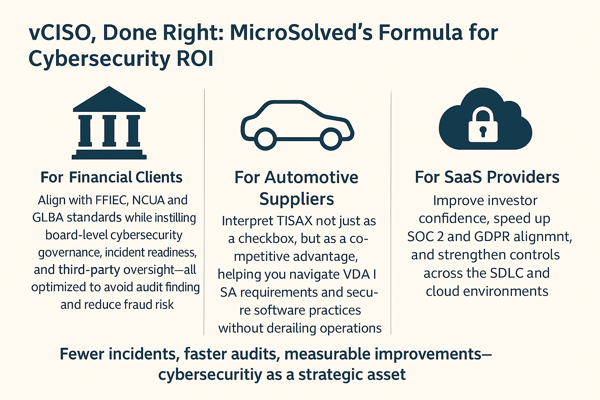At MicroSolved, we don’t just offer virtual CISO (vCISO) services—we deliver tailored, deeply integrated security leadership that aligns precisely with your organization’s risk posture and regulatory obligations.
 Unlike one-size-fits-all models, our vCISO engagements begin with immersive understanding: of your business model, sector-specific compliance demands (think NCUA/FFIEC for credit unions, TISAX for auto suppliers, GDPR/SOC2 for SaaS), and your organizational risk appetite. From there, we build a living security program that’s actionable, measurable, and defensible under scrutiny.
Unlike one-size-fits-all models, our vCISO engagements begin with immersive understanding: of your business model, sector-specific compliance demands (think NCUA/FFIEC for credit unions, TISAX for auto suppliers, GDPR/SOC2 for SaaS), and your organizational risk appetite. From there, we build a living security program that’s actionable, measurable, and defensible under scrutiny.
For Financial Clients
Our vCISO services help align your practices with FFIEC, NCUA, and GLBA standards while instilling board-level cybersecurity governance, incident readiness, and third-party oversight—all optimized to avoid audit findings and reduce fraud risk.
For Automotive Suppliers
We interpret TISAX not just as a checkbox, but as a competitive advantage. Our guidance turns compliance into differentiation, helping you navigate VDA ISA requirements, supplier expectations, and secure software practices without derailing operations.
For SaaS Providers
The ROI of our vCISO services is crystal-clear—better investor confidence, faster SOC2 and GDPR alignment, and stronger controls across the SDLC and cloud environments. We help secure customer trust in the most literal sense.
Clients report real, quantifiable benefits: fewer security incidents, faster audit turnaround, streamlined vendor assessments, and measurable improvements in KPI dashboards, from MTTD to patch latency.
Whether you’re scaling or just stabilizing, MicroSolved’s vCISO offering is more than advisory—it’s a business enabler with cybersecurity as a strategic asset.
* AI tools were used as a research assistant for this content, but human moderation and writing are also included. The included images are AI-generated.

 CUSO Security Oversight Challenges
CUSO Security Oversight Challenges